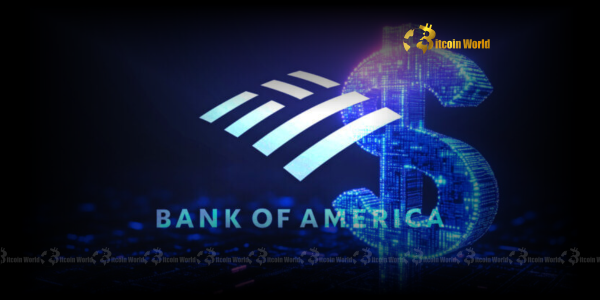BitcoinWorld

Ethereum’s Pivotal Role: Bank of America’s Insight into the Future of Stablecoins
In the rapidly evolving world of digital finance, a significant nod from a traditional financial titan can send ripples across the entire landscape. Recently, Bank of America (BoA), a global banking behemoth, released its insightful “On Chain” report, spotlighting Ethereum as a cornerstone in the burgeoning stablecoin sector. This isn’t just another report; it’s a powerful affirmation of blockchain technology’s increasing relevance and a clear signal of where institutional interest is heading. For anyone tracking the pulse of the crypto market, this development underscores the growing synergy between established finance and the decentralized frontier.
Bank of America’s Bold Statement: Why It Matters for the Crypto Market
When a venerable institution like Bank of America publishes a report specifically naming a cryptocurrency, it carries immense weight. Their “On Chain” report isn’t just a casual observation; it’s a meticulously researched document that delves into the mechanics and potential of digital assets. By highlighting Ethereum as a key player in the stablecoin market, BoA is effectively validating a significant segment of the digital economy. This recognition from a top-tier bank signals a maturing perspective on cryptocurrencies, moving beyond mere speculation to acknowledging their foundational role in future financial infrastructure.
What does this mean for the broader crypto market? Firstly, it lends credibility. For years, digital assets operated on the fringes, often dismissed by mainstream finance. Now, we’re seeing a shift where major banks are not only studying but actively acknowledging the utility and potential of blockchain networks. This can pave the way for:
- Increased Mainstream Acceptance: As more traditional institutions engage, the perception of crypto shifts from niche to legitimate.
- Regulatory Clarity: Bank interest often precedes regulatory frameworks. BoA’s report could encourage clearer guidelines, fostering a more secure environment for growth.
- Enhanced Investment Flows: Institutional validation can open doors for more conservative investors who previously shied away from the perceived volatility and uncertainty of the crypto space.
This report is more than just an analysis; it’s a strategic indicator of the direction traditional finance is likely to take, viewing certain digital assets not as competitors but as integral components of a modernized financial ecosystem.
Ethereum’s Unrivaled Dominance in the Stablecoin Sector
The report emphasizes a critical statistic: over 50% of all stablecoins currently reside on the Ethereum network. This isn’t by chance; it’s a testament to Ethereum’s robust infrastructure, network effects, and pioneering role in smart contracts. But what makes Ethereum the preferred home for these dollar-pegged digital assets?
Ethereum’s Core Strengths for Stablecoins:
- First-Mover Advantage & Network Effect: Ethereum was the first blockchain to offer a widely adopted smart contract platform, enabling the creation of tokens like ERC-20, which stablecoins utilize. This led to a powerful network effect, attracting developers, users, and liquidity.
- Security and Decentralization: As one of the most decentralized and battle-tested blockchains, Ethereum offers a high degree of security. This is paramount for stablecoins, which often represent significant value and require unwavering reliability.
- Vast Developer Ecosystem: Ethereum boasts the largest and most active developer community in the blockchain space. This ensures continuous innovation, maintenance, and the creation of tools and protocols that benefit stablecoin issuers.
- Interoperability with DeFi: The vast majority of decentralized finance (DeFi) protocols are built on Ethereum. Stablecoins are the lifeblood of DeFi, used for lending, borrowing, trading, and yield farming. This deep integration makes Ethereum the natural habitat for stablecoins seeking utility and liquidity.
While challenges like high gas fees have historically plagued Ethereum, ongoing upgrades (like the transition to Proof-of-Stake and the development of Layer-2 scaling solutions such as Arbitrum and Optimism) are addressing these issues, further solidifying its position. The fact that the majority of stablecoin value is locked on Ethereum underscores its fundamental importance to the digital economy, making it a powerful force for stability and growth.
What Drives Institutional Adoption of Stablecoins?
The Bank of America report points to growing institutional adoption as a key driver for stablecoin expansion, which in turn benefits Ethereum. But why are traditional financial institutions, corporations, and large-scale investors increasingly looking at stablecoins?
Key Drivers for Institutional Interest:
| Driver | Explanation |
|---|---|
| Efficiency & Speed | Stablecoins enable near-instantaneous, 24/7 transfers of value globally, bypassing traditional banking hours and lengthy settlement times. This is crucial for cross-border payments and inter-company transfers. |
| Reduced Costs | Compared to traditional wire transfers or international payment systems, stablecoin transactions often incur significantly lower fees, especially for large volumes. |
| Programmability | Built on smart contract platforms like Ethereum, stablecoins can be programmed for specific uses, enabling automated payments, escrow services, and complex financial instruments without intermediaries. |
| Access to DeFi Yields | Institutions can deploy stablecoin holdings into DeFi protocols to earn yields that often surpass those available in traditional finance, creating new revenue streams. |
| Hedging & Liquidity | Stablecoins provide a stable, liquid on-ramp and off-ramp for crypto trading, allowing institutions to quickly move in and out of volatile assets without converting back to fiat. |
This growing interest from institutional players is a game-changer. Their participation brings not just capital but also a demand for robust infrastructure, regulatory clarity, and enterprise-grade solutions, all of which indirectly bolster the underlying networks like Ethereum that host these assets.
The Future of Stablecoins: Navigating Regulatory Momentum
The phrase “regulatory momentum” is a powerful one in the context of stablecoins. As Bank of America suggests, clear and consistent regulation is not a hindrance but a catalyst for widespread adoption. The current landscape for stablecoins is fragmented, with different jurisdictions proposing various approaches. However, a global push towards comprehensive frameworks is undeniable.
Why Regulation is Crucial for Stablecoins and Ethereum:
- Consumer Protection: Regulations aim to protect users by ensuring stablecoins are adequately backed and transparently managed.
- Financial Stability: Governments and central banks want to ensure stablecoins don’t pose systemic risks to the broader financial system.
- Combating Illicit Activities: Clear rules help prevent stablecoins from being used for money laundering or terrorist financing.
- Fostering Innovation: Paradoxically, well-defined regulations can encourage innovation by providing certainty for businesses and developers.
For Ethereum, the impact of regulatory clarity on stablecoins is profoundly positive. If stablecoins gain clear legal standing and operational guidelines, their utility and adoption will explode. This would translate directly into increased transaction volume, network usage, and fee generation for Ethereum, further solidifying its economic model and potentially increasing its value as stablecoin adoption expands, as analysts suggest.
The U.S., EU, and other major economies are actively debating and implementing stablecoin legislation. The emergence of central bank digital currencies (CBDCs) also plays into this narrative, as governments explore their own digital currency options, potentially coexisting with or influencing the trajectory of private stablecoins.
Beyond Stablecoins: How This Impacts the Broader Ethereum Ecosystem
While the Bank of America report specifically highlights Ethereum‘s role in stablecoins, the implications extend far beyond this single use case. The increased usage and institutional interest driven by stablecoins have a ripple effect across the entire Ethereum ecosystem and the broader crypto market.
Benefits for Ethereum’s Growth:
- Increased Network Revenue: More stablecoin transactions mean more gas fees paid to the network. With Ethereum’s EIP-1559 upgrade, a portion of these fees is burned, making ETH a deflationary asset over time.
- Enhanced Security: Higher network usage and value locked in stablecoins incentivize more validators to secure the Proof-of-Stake network, making it even more robust against attacks.
- Developer Magnet: A thriving ecosystem with clear institutional interest attracts more talented developers, leading to more innovative applications and services built on Ethereum.
- Value Accrual: As a foundational layer for such a significant part of the digital economy, Ethereum’s native asset, ETH, is positioned to accrue value from the growth of stablecoins and the broader DeFi landscape they underpin.
- Catalyst for Layer-2 Adoption: The demand for efficient stablecoin transfers on Ethereum pushes the adoption of Layer-2 scaling solutions, which will ultimately benefit the entire network’s scalability.
The synergy is clear: the success of stablecoins on Ethereum directly contributes to the health and growth of the Ethereum network itself. This feedback loop creates a powerful positive cycle, cementing Ethereum’s status as a critical piece of the future financial infrastructure.
Challenges and Opportunities Ahead
Despite the optimistic outlook, challenges remain. Competition from other Layer-1 blockchains vying for stablecoin dominance, the ongoing need for scalable solutions, and the complexities of global regulatory harmonization are all factors that will shape the future. However, these challenges also present immense opportunities for innovation and collaboration within the crypto space.
For individuals and institutions, understanding these dynamics is crucial. The insights from Bank of America provide a valuable lens through which to view the evolving digital asset landscape. It’s a testament to the fact that cryptocurrencies, particularly those with strong fundamentals and real-world utility like Ethereum, are increasingly becoming undeniable forces in global finance.
Conclusion: A New Era of Financial Convergence
Bank of America’s recent report serves as a powerful validation of Ethereum‘s critical role in the burgeoning stablecoin market. With over half of all stablecoins residing on its network, Ethereum is undeniably positioned to gain significant value as regulatory momentum builds and institutional adoption accelerates. This convergence of traditional finance and blockchain technology signifies a profound shift, moving digital assets from the periphery to the core of global financial discussions. The future of the crypto market, bolstered by stablecoin utility and institutional confidence, looks increasingly integrated and robust, with Ethereum at its very heart.
To learn more about the latest crypto market trends, explore our article on key developments shaping Ethereum institutional adoption.
This post Ethereum’s Pivotal Role: Bank of America’s Insight into the Future of Stablecoins first appeared on BitcoinWorld and is written by Editorial Team





